The 2015 MacBook Review
by Ryan Smith on April 14, 2015 10:15 AM ESTUSB Type-C: Charging Power, Display, & Data All in One
Another big first for an Apple product is the inclusion of a USB Type-C connector. The connector has been in development by the USB Implementers Forum for some time, and was finalized by the group in August of last year.
The Type-C connector is intended to serve multiple purposes for the USB-IF and device makers such as Apple. Functionally it is the next-generation connector for USB, designed to replace the various sizes of USB Type-A and Type-B connectors that have been with us for nearly 20 years. In updating their connector, the USB-IF has focused on correcting flaws (perceived or otherwise) in their existing connectors while laying down the groundwork for the next 20 years by adding pins and features such as USB Alternate Modes.
But before I get too far ahead of myself, we should probably start with the biggest reasons for Type-C, and it’s only fitting that for a thin & light device like the MacBook these are about going small. The Type-C connector is both smaller than USB 3.0 connectors (even Micro-B) and for the first time in a USB connector it’s symmetrical and reversible. With an end goal of developing an Apple Lightning-like connector (and as Apple likes to remind everyone, they serve on the USB-IF as well), the USB Type-C connector comes on to the market as the universal version of that connector, designed to drive data, power, and even displays.
In conjunction with defining the new connector and cable standards, Type-C also goes hand-in-hand with defining new features, the USB Power Delivery Specification and the USB Alternate Modes specification. Though to be clear these are optional specifications don’t apply to all Type-C devices (the Type-C can be used with even USB 2.0 devices), they do apply to the MacBook, where they drive additional functionality. The Power Delivery specification defines how much greater amounts of power – up to 100W – can be carried over a USB cable, allowing for USB cables to charge tablets, and yes, even laptops as in the case of the MacBook. Meanwhile the Alternate Modes specification defines how other protocols can be carried over the cable in place of some of its USB 3.0 “Superspeed” functionality, the most important of which is DisplayPort video.
All of these features are tapped for the MacBook, and as a result the Type-C port is the do-everything port for the MacBook. It’s through the Type-C port that the MacBook is charged, it’s through the Type-C port that USB devices such as flash drives and Ethernet adapters are attached, and it’s through the Type-C port that DisplayPort video is carried out of the MacBook to external displays.
USB Type-C will be the future of USB, and ultimately we would expect to see all devices replace their Type-A/B connectors with Type-C in the long run. But for the moment the MacBook is among the first devices that features Type-C, which means it’s on the bleeding edge for all the benefits and drawbacks. From a feature standpoint Type-C works well, but until it’s well established there will be confusion over the standard, particularly over the interaction between Type-C and USB 3.1.
| USB Standards | ||
| Standard | Max Speed | Alt. Name |
| USB 2.0 | 480Mbps | High Speed |
| USB 3.0 | 5Gbps | Superspeed |
| USB 3.1 Gen 1 | 5Gbps | SuperSpeed |
| USB 3.1 Gen 2 | 10Gbps | SuperSpeed+ |
Case in point: as per the USB 3.1 standard, Apple officially classifies the MacBook as a USB 3.1 Gen 1 device. What is USB 3.1 Gen 1? The answer is that it’s really USB 3.0, with the USB 3.1 standard having adopted USB 3.0 and given it a new name. In this case Apple is using Core M’s built-in USB 3.0 controller to drive their Type-C port, and that means it has the same bandwidth capabilities as any other USB 3.0 port, meaning 5Gbps “Superspeed” capabilities. USB 10Gbps “Superspeed+” on the other hand, which is already commonly known as USB 3.1, is actually called USB 3.1 Gen 2, and is just now appearing on the market in other devices. At this time Gen 2 requires separate controllers – no chipset has built-in support – and given the design goals of the MacBook it comes as no surprise that Apple has minimized their use of separate controllers in order to save power and space.

Left-To-Right: USB 2.0 Micro-B, Lightning, USB Type-C, MiniDisplayPort, USB 2.0 Type-A
In any case, while the MacBook doesn’t support 10Gbps USB, it does support all of the other major features, and it is for the most part awesome. Jokes about USB Type-A superposition aside, the Type-C connector is a clear improvement over Type-A for anyone that has ever struggled with getting a device plugged in the first place. Either way is the right way, making it far, far easier to plug in new devices. Meanwhile the new connector is only marginally wider than Apple’s Lightning connector, so while we don’t have a ton of space-constrained devices with Type-C so far other than the MacBook, it’s similarly an improvement over USB 2.0 (and especially USB 3.0) Micro-B. In terms of mechanical design there’s really nothing bad I can say about USB Type-C; in the long run this is a much better connector than Type-A.
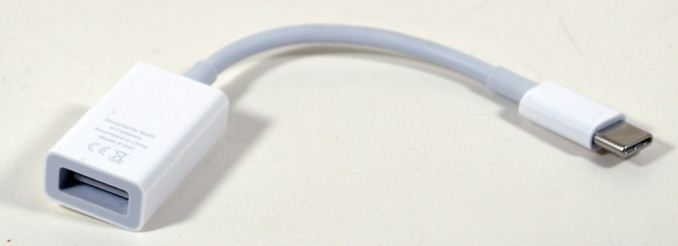
Apple's USB Type-C Male To Type-A Female Adapter
Short-term however there are definite teething issues. Primarily due to the fact that almost no peripherals support Type-C yet other than Apple’s included charger, for most anything else you will need to use a Type-A to Type-C adapter, which Apple sells for $20 but does not include with the laptop. The adapter will allow you to plug in typical USB peripherals and even supports USB 3.0/USB 3.1 Gen 1 speeds, but it’s a definite oversight/stinginess on Apple’s part right now to not include it given the lack of compatible peripherals. Longer term this won’t be a problem, SanDisk for example already has a Type-C flash drive on its way, but for the moment MacBook owners will want the adapter.

Sandisk's Forthcoming USB Type-C/Type-A Duo Drive
Moving on, using USB Type-C as the means to charge the MacBook is not unexpected given the standard’s new capabilities. Apple’s included 29W charger can deliver 2A @ 14.5V for devices that comply with the USB power delivery specification, and 2.4A @ 5.2V for older USB battery charging devices (phones, tablets, etc). Conceptually this means that Apple’s power adapters are no longer proprietary, and the MacBook should be able to accept other chargers that deliver the required amount of power while Apple’s charger can charge similar devices.
The catch is that this means Apple has given up their nifty MagSafe technology in the process. Apple’s magnetic connector has already gone through one shrink and would have needed to go through another shrink for the MacBook – and I’m not entirely sure whether Apple could pull it off – so instead we have the non-magnetic USB Type-C connector. Given the safety aspects of MagSafe I’m sad to see it go, as it has likely saved my MacBook Pro once before. Meanwhile in controlled testing I’m finding that the Type-C connector can take quite a force before coming free of the MacBook, which for a USB peripheral is undoubtedly a good thing, but it’s definitely going to be possible to drag a light laptop like the MacBook off of a cable via the Type-C connector. I don’t imagine Apple had too many other choices here, but MagSafe will be missed.
Along with power and data, the Type-C connector also carries video via the DisplayPort signaling standard, and I had a chance to try this out as well. Using one of Google’s USB Type-C to DisplayPort cables, I was able to connect the MacBook to my Sharp PN-K321 32” 4K display with mostly positive results. In Single Stream Transport (SST) mode, which for the Sharp allows up to 4K@30Hz, I had no problem driving the Sharp monitor at various resolutions up to its maximum for that mode. However when switching the monitor over to Multi-Stream Transport (MST) for 4K@60Hz, the MacBook flat out did not detect the monitor.
At this point I have not had a chance to try a 4K@60Hz SST monitor, so I’m unsure whether this is a specific MST incompatibility, cable incompatibility, or if the MacBook doesn’t support 4K@60Hz (Apple for their part does not specify). Given the lack of detection I’m wondering whether Apple only supports up to 2 lanes of DisplayPort (4 are needed for 4K@60Hz), but without further confirmation that’s just a guess. Regardless a low-power device like the MacBook is not a great candidate for driving a 4K@60Hz display, but for the moment we can only confirm the MacBook works with displays up to 4K@30Hz.
Last but certainly not least when it comes to the MacBook’s USB connectivity is the elephant in the room, which is the number of USB ports. As we mentioned in our look at the MacBook’s overall design, the laptop only ships with a single Type-C port, and that’s it. The only other port on the MacBook is a 3.5mm audio jack, which means the sole Type-C port is only the only port for power, for data, and for external displays.
The issue, quite simply put, is that without external adapters you cannot charge the MacBook and use USB peripherals or external display at the same time. Want to install Boot Camp? You’ll need to do so on battery power. An external display? Same story. Apple has slowly whittled down the number of connectors they feature over time – the MacBook Air 11” ships with just 2 USB ports, a Thunderbolt 2 port, and a MagSafe port – but the MacBook is alone in only featuring a single data/display/power port.
Well that isn’t entirely true. Apple does make one other device like that, and that’s their iOS devices. From a physical standpoint I question whether Apple would even be able to attach another Type-C port (likely not without reducing the curve or making the device thicker), but from a design standpoint I get the distinct impression that the use cases Apple is envisioning are very iPad-like, where a device is taken out for the day on battery power, any data connectivity is done over WiFi, and at the end of the day it is brought back home to charge overnight.
Apple has always aimed for the cutting edge in this respect, and while I get where they’re going here, it’s difficult to agree with their design decision. The MacBook is still first and foremost a laptop despite its crossover design, and laptops continue to be used with peripherals. Ethernet adapters, USB flash drives, and mobile devices such as phones and tablets are not going away any time soon, and all of these devices are things you may want to attach to the MacBook, and probably while charging said MacBook too.
The good news is that Apple does sell Type-C multiport adapters that serve as a breakout box for more ports – Type-C for power, USB 3.1 Gen 1 Type-A for peripherals, and HDMI 1.4 for video out – but of course this is an additional $79 cost and is one more item to carry around.
Right now I’m of the opinion that Apple should have shipped the MacBook with 2 Type-C ports (and without replacing the 3.5mm audio jack), primarily to allow the device to be charged and used with a peripheral without requiring additional adapters. To be sure the MacBook is easy to get along with most of the time, and in most cases it’s not a problem to stop charging it for a bit to use a peripheral, but we’re not quite at the point where a single port is always going to be sufficient. In the meantime I will also fully admit that there are technical issues with multiple ports – how do you route power and video now that it can come in and out of multiple ports – but these are issues I’m confident Apple could resolve.


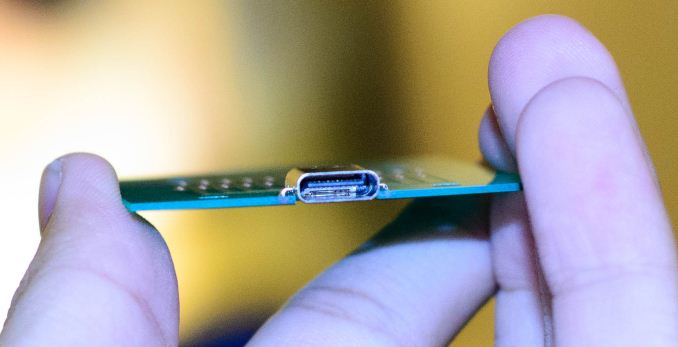
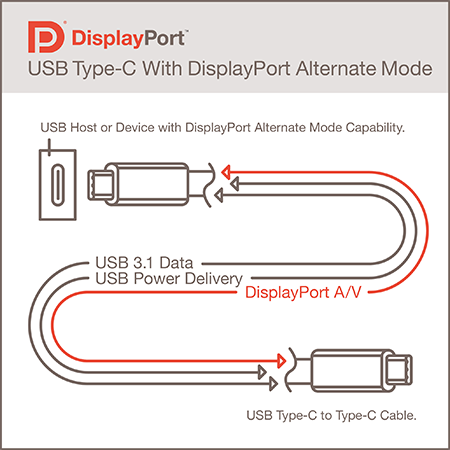
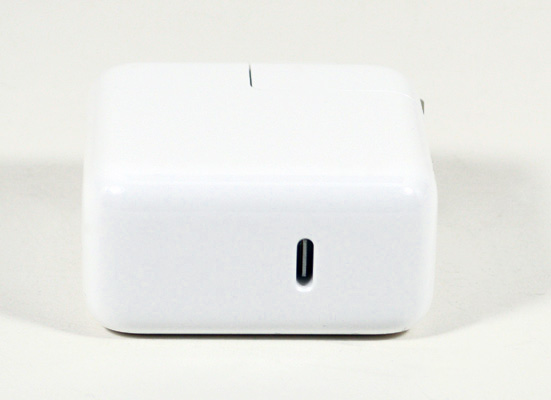
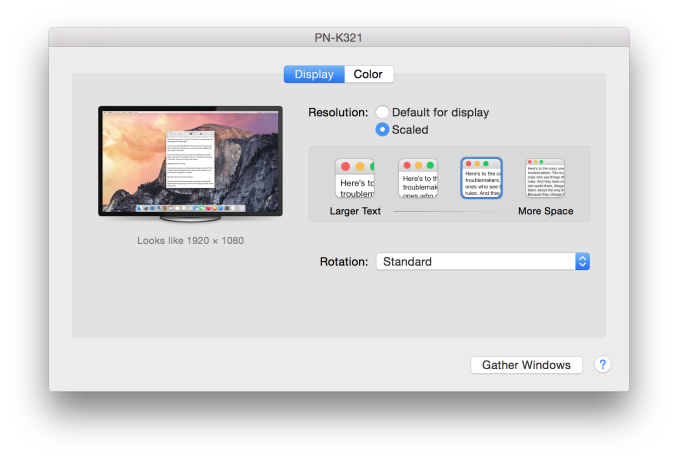
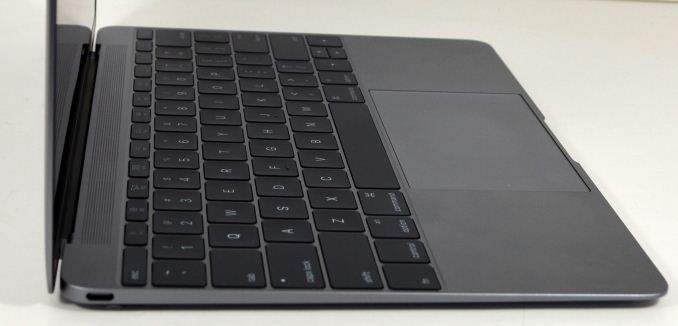
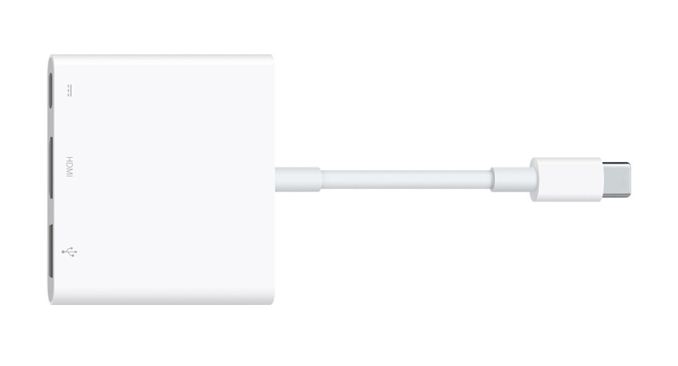








354 Comments
View All Comments
tpoccu - Friday, April 17, 2015 - link
Did you write something similar about the original MacBook Air, you know the one that cost about 3 times as much as this, also had only USB, video out (micro-DVI if memory serves which nothing else ever used), and a headphone jack, and had atrocious performance compared to its contemporaries? The same MacBook Air that only one redesign later would go on to become the defacto standard for how mainstream laptops are built now. I suppose it is easier to rant without any use for foresight.Schickenipple - Monday, April 20, 2015 - link
Seriously, BittenRottenApple: You need to get laid.All companies will do whatever they can to sell whatever they can because they want to make money and people will continue to buy their stuff. If being 'informed' means that consumers will turn into you and start spouting useless crap on technology forums for hours at a time, then they would probably rather pay a lot of money for a new OS X device and have some fun. Even if it is just a sweet-looking netbook. Grow up and quit wasting your energy on this stuff.
Also: Change your username to something less troll-like and cliché. We all knew exactly how your comment would read before even reading it.
karpodiem - Monday, April 20, 2015 - link
I laughed through reading some of this, but agreed with much of it than I disagreed with.Spot on
star-affinity - Friday, April 24, 2015 - link
”They eliminate all ports except for one outdated USB port?”How is it outdated? USB 3.1 barely just hit the market.
”Other operating systems can be installed on just about any computer you can slap together, whereas OSX is specifically and deliberately designed to be non-functional on ANYTHING that isn’t made by apple.”
Not true – OS X works very well on my Hackintosh with very few modifications.
I wouldn't get this MacBook, but the recently updated 13" MacBook Pro looks quite nice in my book. I think OS X is worth a lot. There's less hassle with it overall (compared to Windows) and I can work much more switfly using it (less actions/steps needed for most common tasks). I say this working at an IT department at an office where there's computers running both Windows and OS X.
You don't have to like Apple or their products, but I don't thinks your criticism (or should I say rant) is very balanced.
sunnohh - Saturday, April 25, 2015 - link
Computers last 2 years for most Apple users 3 tops. Source former Apple certified repair tech. 1300 isn't that much money. And as a dedicated PC gamer with a Titan rig 24 USB ports; gigs of ram and inches of monitor; this MacBook seems like a great little second machine. I prefer portability in a laptop to power and as a somewhat fancy individual there are literally zero times I would ever need a port on a laptop other than power, which with an 8 hr battery can be discretely done from home. Some people have grown up jobs and need shiny Apple products and Mercedes cars to fit in at work.I am an extremely informed PC builder yet I choose Apple products because they are astonishingly high performing elegant bits of jewelry/PC. Ever compare the hinges on a MacBook to a Lenovo or asus? Good Christ. Apple sound quality? 100% better then the next best PC or android bar none. And I've tried everything and seen every measurement not even close. Color quality check.
Sure it's a cult but it's reasonably priced for the quality, especially compared to a Benz. And the best part of Apple ownership is I can have Apple pie and windows and it's ok. Seriously it's fucking awesome.
vista980622 - Wednesday, May 20, 2015 - link
There are some valid points there, and as a semi-professional video editor + graphics designer, I definitely know I'm not its' target audience. The new MacBook is designed for people who use computer differently than we do, and I'm glad a lot of my friends and people around me love the tiny laptop that is beautiful and light.vista980622 - Wednesday, May 20, 2015 - link
And I do enjoy the XPS 13 :)farhanshaikh74 - Sunday, May 24, 2015 - link
I was die hard apple fan from so many years and used to propagate apple products to such an extent that I am called Late Steve Job's best marketing guy in my hospital!However over last three years as Apple has stopped producing simple MacBook pro which are upgradeable (like mid 2012 MacBook pro) with DVD drive, I am feeling their vision of "design should include how things work" philosophy is losing its sheen.
Now they are selling only MacBook Retina, no non-retina laptops!, No laptops with DVD drive!! No laptops with 8GB RAM with normal Hard disk Drive which is upgradeable!!!
They are forcing us to buy ONLY Retian, with a fixed Flash drive which is meagre 126Gb or 256 GB, and those which come with 500 GB are exorbitantly costly.
They are forcing us to use iCloud for storage, without realising that in many parts of the world accessibility to WiFi and iCloud.
I am serious restricted by fixed 256GB Flash drive on my late 2013 Retina MacBook pro as I bought this expensive laptop, but struggling for space and the Flashdrive is not upgradeable!!
From last one week I am seriously considering Apple products and going back to Windows.
The design team in Apple is ignorant to a large population, who loves apple products and have moderate budget, they are busy catering only to high end products at premium price.
If this continues, they will find very few people using iOS in future and Apple will die its own death.
This is serious, as a die hard fan of Apple like me is writing such a comment!
Stimpak_Addict - Tuesday, June 9, 2015 - link
Check out Thunderbolt 3. It seems like they made this form factor to accommodate it once it's finalized (and hopefully they'll include at least 2 Thunderbolt 3 ports with the next iteration).jdw1992 - Sunday, June 14, 2015 - link
I have to point out a serious area you lack on knowledge. You berate USB as being outdated compared to thunderbolt. If you were speaking of anything but USB C you would be correct. However, and I do not know why Apple did not point this out, USB C and thunderbolt are now one and the same. Intel announced that the standard known as Thunderbolt is now part of the USB C standard. In other words, Apple is the first to land the next generation of peripheral ports, the most versatile and fast one to date.